Entrepreneurial Marketing Report: Small Business Environment Analysis
VerifiedAdded on 2023/01/23
|8
|2334
|78
Report
AI Summary
This report provides a comprehensive overview of entrepreneurial marketing, focusing on the unique challenges and opportunities faced by small businesses and new ventures. It begins by outlining the key characteristics of the small business marketing environment, including factors such as lower income, smaller teams, and limited market reach. The report then delves into the various issues encountered by new ventures, such as overhead management, regulatory compliance, cybersecurity risks, and cash flow problems. Furthermore, it explores standard marketing theories and practices within the context of small businesses, emphasizing the importance of adapting traditional strategies to fit the specific needs and constraints of these organizations. The report also highlights the learning skills crucial for problem-solving, self-management, and effective communication, which are essential for success in entrepreneurial marketing. Finally, the report concludes by summarizing the key differences in decision-making between small and large companies, emphasizing the role of innovation, creativity, and risk-taking in entrepreneurial ventures.

Entrepreneurial Marketing
Paraphrase This Document
Need a fresh take? Get an instant paraphrase of this document with our AI Paraphraser
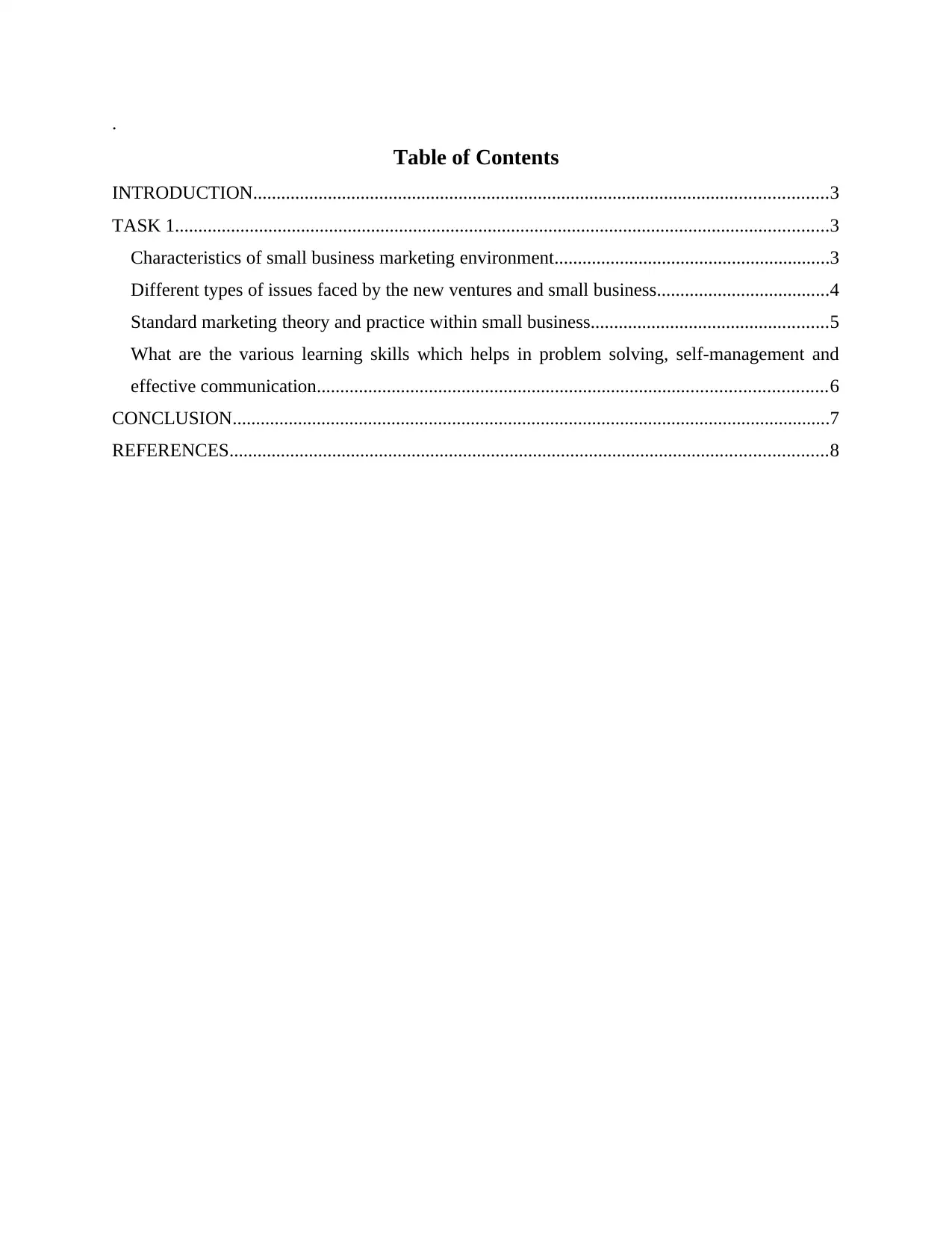
.
Table of Contents
INTRODUCTION...........................................................................................................................3
TASK 1............................................................................................................................................3
Characteristics of small business marketing environment...........................................................3
Different types of issues faced by the new ventures and small business.....................................4
Standard marketing theory and practice within small business...................................................5
What are the various learning skills which helps in problem solving, self-management and
effective communication.............................................................................................................6
CONCLUSION................................................................................................................................7
REFERENCES................................................................................................................................8
Table of Contents
INTRODUCTION...........................................................................................................................3
TASK 1............................................................................................................................................3
Characteristics of small business marketing environment...........................................................3
Different types of issues faced by the new ventures and small business.....................................4
Standard marketing theory and practice within small business...................................................5
What are the various learning skills which helps in problem solving, self-management and
effective communication.............................................................................................................6
CONCLUSION................................................................................................................................7
REFERENCES................................................................................................................................8
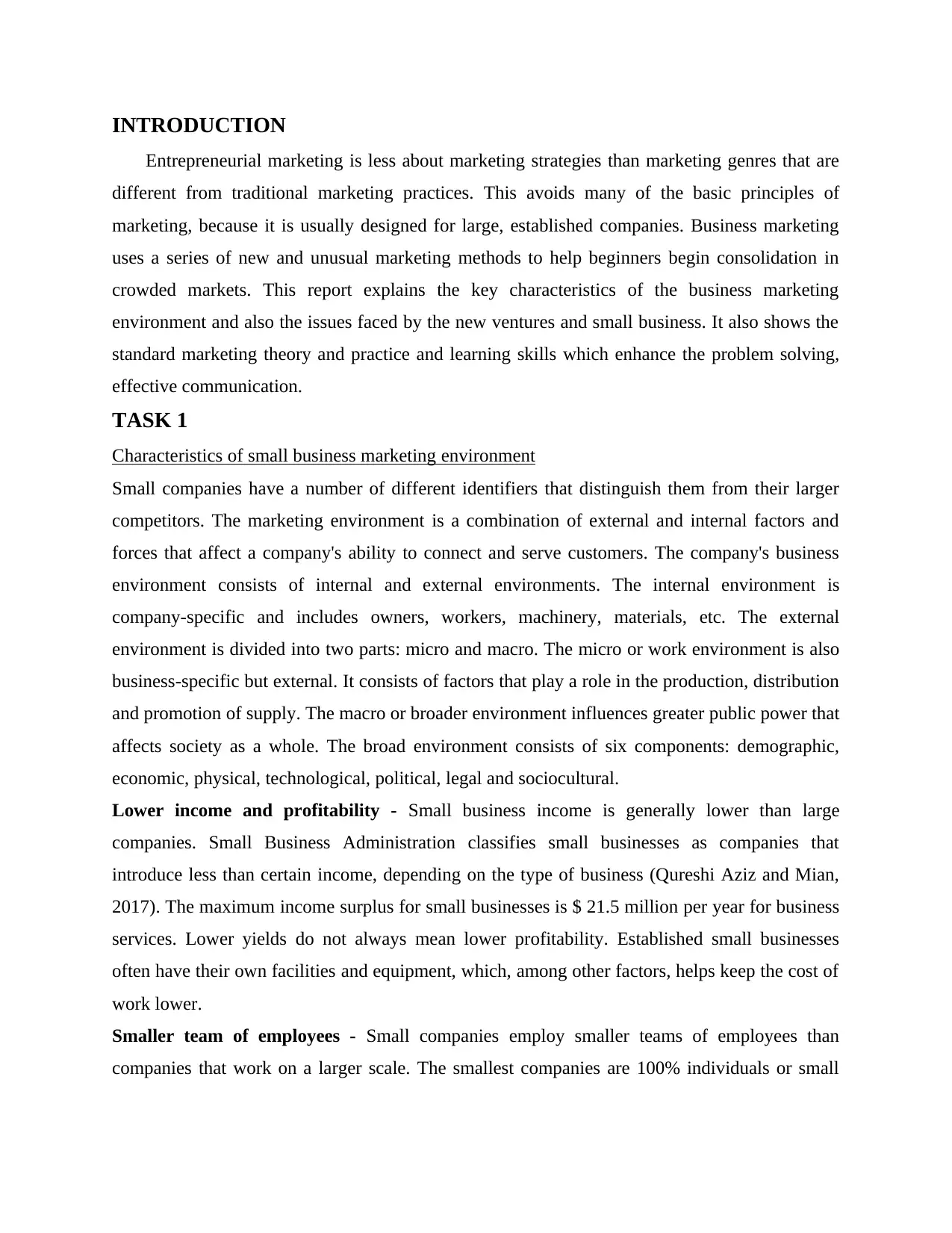
INTRODUCTION
Entrepreneurial marketing is less about marketing strategies than marketing genres that are
different from traditional marketing practices. This avoids many of the basic principles of
marketing, because it is usually designed for large, established companies. Business marketing
uses a series of new and unusual marketing methods to help beginners begin consolidation in
crowded markets. This report explains the key characteristics of the business marketing
environment and also the issues faced by the new ventures and small business. It also shows the
standard marketing theory and practice and learning skills which enhance the problem solving,
effective communication.
TASK 1
Characteristics of small business marketing environment
Small companies have a number of different identifiers that distinguish them from their larger
competitors. The marketing environment is a combination of external and internal factors and
forces that affect a company's ability to connect and serve customers. The company's business
environment consists of internal and external environments. The internal environment is
company-specific and includes owners, workers, machinery, materials, etc. The external
environment is divided into two parts: micro and macro. The micro or work environment is also
business-specific but external. It consists of factors that play a role in the production, distribution
and promotion of supply. The macro or broader environment influences greater public power that
affects society as a whole. The broad environment consists of six components: demographic,
economic, physical, technological, political, legal and sociocultural.
Lower income and profitability - Small business income is generally lower than large
companies. Small Business Administration classifies small businesses as companies that
introduce less than certain income, depending on the type of business (Qureshi Aziz and Mian,
2017). The maximum income surplus for small businesses is $ 21.5 million per year for business
services. Lower yields do not always mean lower profitability. Established small businesses
often have their own facilities and equipment, which, among other factors, helps keep the cost of
work lower.
Smaller team of employees - Small companies employ smaller teams of employees than
companies that work on a larger scale. The smallest companies are 100% individuals or small
Entrepreneurial marketing is less about marketing strategies than marketing genres that are
different from traditional marketing practices. This avoids many of the basic principles of
marketing, because it is usually designed for large, established companies. Business marketing
uses a series of new and unusual marketing methods to help beginners begin consolidation in
crowded markets. This report explains the key characteristics of the business marketing
environment and also the issues faced by the new ventures and small business. It also shows the
standard marketing theory and practice and learning skills which enhance the problem solving,
effective communication.
TASK 1
Characteristics of small business marketing environment
Small companies have a number of different identifiers that distinguish them from their larger
competitors. The marketing environment is a combination of external and internal factors and
forces that affect a company's ability to connect and serve customers. The company's business
environment consists of internal and external environments. The internal environment is
company-specific and includes owners, workers, machinery, materials, etc. The external
environment is divided into two parts: micro and macro. The micro or work environment is also
business-specific but external. It consists of factors that play a role in the production, distribution
and promotion of supply. The macro or broader environment influences greater public power that
affects society as a whole. The broad environment consists of six components: demographic,
economic, physical, technological, political, legal and sociocultural.
Lower income and profitability - Small business income is generally lower than large
companies. Small Business Administration classifies small businesses as companies that
introduce less than certain income, depending on the type of business (Qureshi Aziz and Mian,
2017). The maximum income surplus for small businesses is $ 21.5 million per year for business
services. Lower yields do not always mean lower profitability. Established small businesses
often have their own facilities and equipment, which, among other factors, helps keep the cost of
work lower.
Smaller team of employees - Small companies employ smaller teams of employees than
companies that work on a larger scale. The smallest companies are 100% individuals or small
⊘ This is a preview!⊘
Do you want full access?
Subscribe today to unlock all pages.

Trusted by 1+ million students worldwide
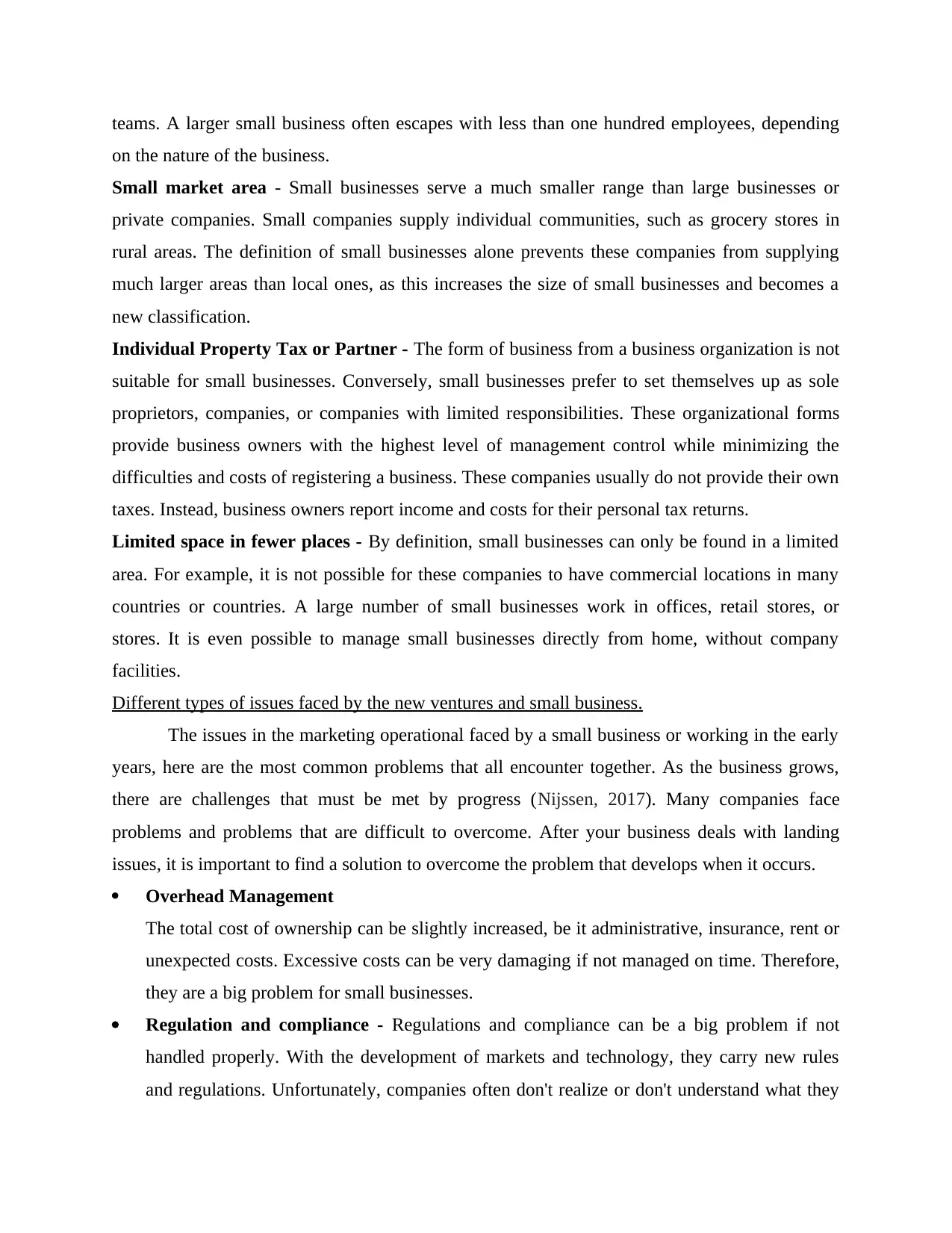
teams. A larger small business often escapes with less than one hundred employees, depending
on the nature of the business.
Small market area - Small businesses serve a much smaller range than large businesses or
private companies. Small companies supply individual communities, such as grocery stores in
rural areas. The definition of small businesses alone prevents these companies from supplying
much larger areas than local ones, as this increases the size of small businesses and becomes a
new classification.
Individual Property Tax or Partner - The form of business from a business organization is not
suitable for small businesses. Conversely, small businesses prefer to set themselves up as sole
proprietors, companies, or companies with limited responsibilities. These organizational forms
provide business owners with the highest level of management control while minimizing the
difficulties and costs of registering a business. These companies usually do not provide their own
taxes. Instead, business owners report income and costs for their personal tax returns.
Limited space in fewer places - By definition, small businesses can only be found in a limited
area. For example, it is not possible for these companies to have commercial locations in many
countries or countries. A large number of small businesses work in offices, retail stores, or
stores. It is even possible to manage small businesses directly from home, without company
facilities.
Different types of issues faced by the new ventures and small business.
The issues in the marketing operational faced by a small business or working in the early
years, here are the most common problems that all encounter together. As the business grows,
there are challenges that must be met by progress (Nijssen, 2017). Many companies face
problems and problems that are difficult to overcome. After your business deals with landing
issues, it is important to find a solution to overcome the problem that develops when it occurs.
Overhead Management
The total cost of ownership can be slightly increased, be it administrative, insurance, rent or
unexpected costs. Excessive costs can be very damaging if not managed on time. Therefore,
they are a big problem for small businesses.
Regulation and compliance - Regulations and compliance can be a big problem if not
handled properly. With the development of markets and technology, they carry new rules
and regulations. Unfortunately, companies often don't realize or don't understand what they
on the nature of the business.
Small market area - Small businesses serve a much smaller range than large businesses or
private companies. Small companies supply individual communities, such as grocery stores in
rural areas. The definition of small businesses alone prevents these companies from supplying
much larger areas than local ones, as this increases the size of small businesses and becomes a
new classification.
Individual Property Tax or Partner - The form of business from a business organization is not
suitable for small businesses. Conversely, small businesses prefer to set themselves up as sole
proprietors, companies, or companies with limited responsibilities. These organizational forms
provide business owners with the highest level of management control while minimizing the
difficulties and costs of registering a business. These companies usually do not provide their own
taxes. Instead, business owners report income and costs for their personal tax returns.
Limited space in fewer places - By definition, small businesses can only be found in a limited
area. For example, it is not possible for these companies to have commercial locations in many
countries or countries. A large number of small businesses work in offices, retail stores, or
stores. It is even possible to manage small businesses directly from home, without company
facilities.
Different types of issues faced by the new ventures and small business.
The issues in the marketing operational faced by a small business or working in the early
years, here are the most common problems that all encounter together. As the business grows,
there are challenges that must be met by progress (Nijssen, 2017). Many companies face
problems and problems that are difficult to overcome. After your business deals with landing
issues, it is important to find a solution to overcome the problem that develops when it occurs.
Overhead Management
The total cost of ownership can be slightly increased, be it administrative, insurance, rent or
unexpected costs. Excessive costs can be very damaging if not managed on time. Therefore,
they are a big problem for small businesses.
Regulation and compliance - Regulations and compliance can be a big problem if not
handled properly. With the development of markets and technology, they carry new rules
and regulations. Unfortunately, companies often don't realize or don't understand what they
Paraphrase This Document
Need a fresh take? Get an instant paraphrase of this document with our AI Paraphraser
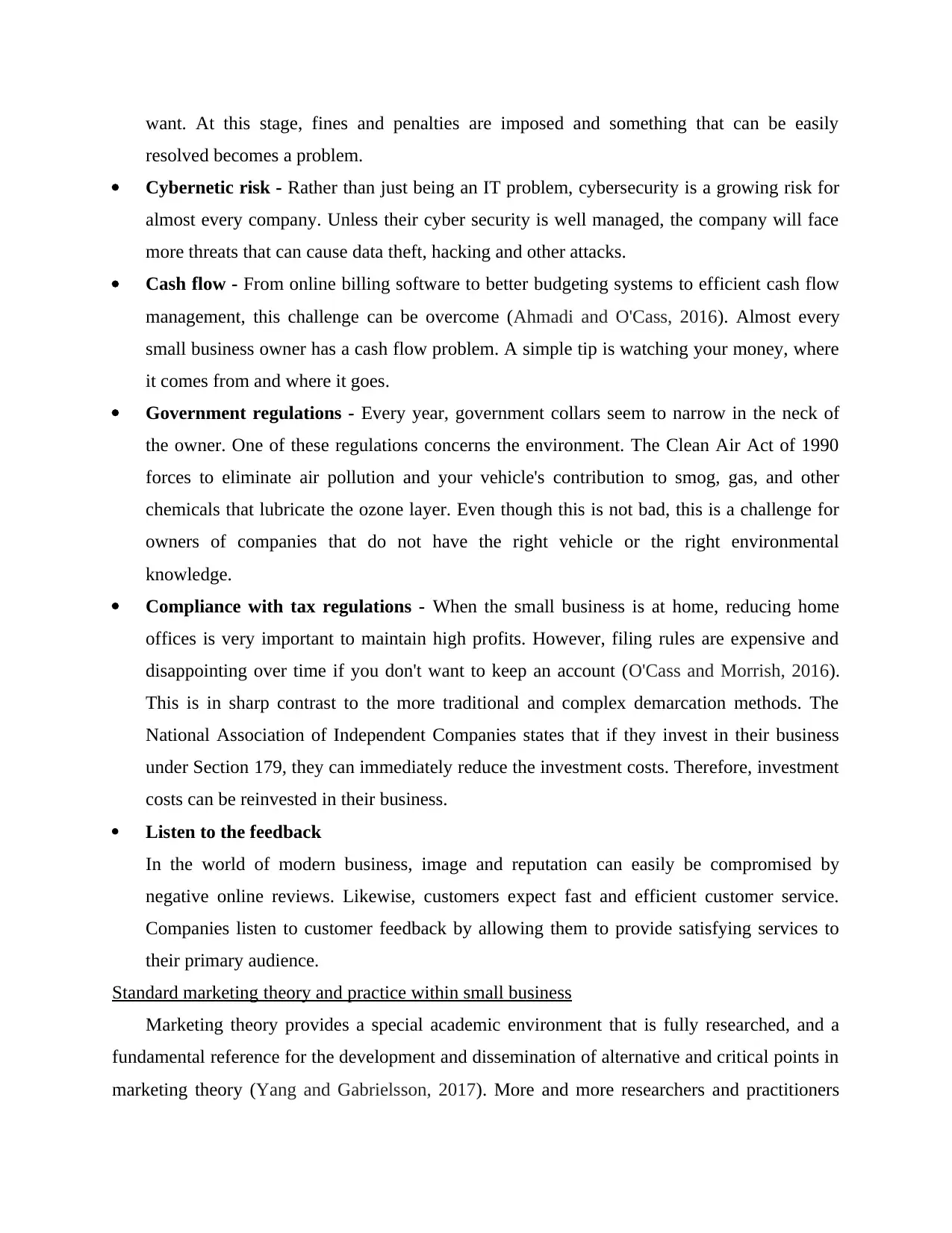
want. At this stage, fines and penalties are imposed and something that can be easily
resolved becomes a problem.
Cybernetic risk - Rather than just being an IT problem, cybersecurity is a growing risk for
almost every company. Unless their cyber security is well managed, the company will face
more threats that can cause data theft, hacking and other attacks.
Cash flow - From online billing software to better budgeting systems to efficient cash flow
management, this challenge can be overcome (Ahmadi and O'Cass, 2016). Almost every
small business owner has a cash flow problem. A simple tip is watching your money, where
it comes from and where it goes.
Government regulations - Every year, government collars seem to narrow in the neck of
the owner. One of these regulations concerns the environment. The Clean Air Act of 1990
forces to eliminate air pollution and your vehicle's contribution to smog, gas, and other
chemicals that lubricate the ozone layer. Even though this is not bad, this is a challenge for
owners of companies that do not have the right vehicle or the right environmental
knowledge.
Compliance with tax regulations - When the small business is at home, reducing home
offices is very important to maintain high profits. However, filing rules are expensive and
disappointing over time if you don't want to keep an account (O'Cass and Morrish, 2016).
This is in sharp contrast to the more traditional and complex demarcation methods. The
National Association of Independent Companies states that if they invest in their business
under Section 179, they can immediately reduce the investment costs. Therefore, investment
costs can be reinvested in their business.
Listen to the feedback
In the world of modern business, image and reputation can easily be compromised by
negative online reviews. Likewise, customers expect fast and efficient customer service.
Companies listen to customer feedback by allowing them to provide satisfying services to
their primary audience.
Standard marketing theory and practice within small business
Marketing theory provides a special academic environment that is fully researched, and a
fundamental reference for the development and dissemination of alternative and critical points in
marketing theory (Yang and Gabrielsson, 2017). More and more researchers and practitioners
resolved becomes a problem.
Cybernetic risk - Rather than just being an IT problem, cybersecurity is a growing risk for
almost every company. Unless their cyber security is well managed, the company will face
more threats that can cause data theft, hacking and other attacks.
Cash flow - From online billing software to better budgeting systems to efficient cash flow
management, this challenge can be overcome (Ahmadi and O'Cass, 2016). Almost every
small business owner has a cash flow problem. A simple tip is watching your money, where
it comes from and where it goes.
Government regulations - Every year, government collars seem to narrow in the neck of
the owner. One of these regulations concerns the environment. The Clean Air Act of 1990
forces to eliminate air pollution and your vehicle's contribution to smog, gas, and other
chemicals that lubricate the ozone layer. Even though this is not bad, this is a challenge for
owners of companies that do not have the right vehicle or the right environmental
knowledge.
Compliance with tax regulations - When the small business is at home, reducing home
offices is very important to maintain high profits. However, filing rules are expensive and
disappointing over time if you don't want to keep an account (O'Cass and Morrish, 2016).
This is in sharp contrast to the more traditional and complex demarcation methods. The
National Association of Independent Companies states that if they invest in their business
under Section 179, they can immediately reduce the investment costs. Therefore, investment
costs can be reinvested in their business.
Listen to the feedback
In the world of modern business, image and reputation can easily be compromised by
negative online reviews. Likewise, customers expect fast and efficient customer service.
Companies listen to customer feedback by allowing them to provide satisfying services to
their primary audience.
Standard marketing theory and practice within small business
Marketing theory provides a special academic environment that is fully researched, and a
fundamental reference for the development and dissemination of alternative and critical points in
marketing theory (Yang and Gabrielsson, 2017). More and more researchers and practitioners
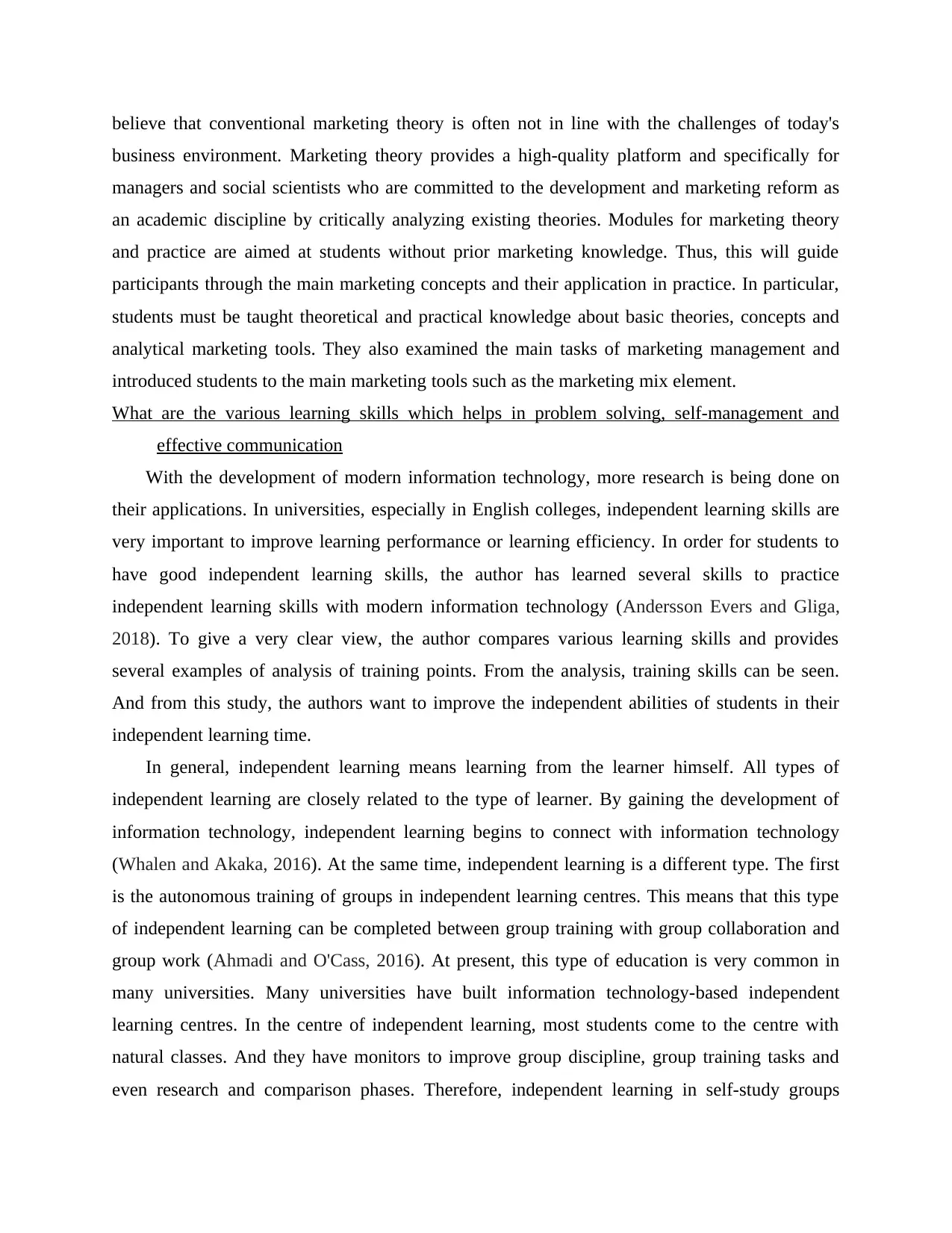
believe that conventional marketing theory is often not in line with the challenges of today's
business environment. Marketing theory provides a high-quality platform and specifically for
managers and social scientists who are committed to the development and marketing reform as
an academic discipline by critically analyzing existing theories. Modules for marketing theory
and practice are aimed at students without prior marketing knowledge. Thus, this will guide
participants through the main marketing concepts and their application in practice. In particular,
students must be taught theoretical and practical knowledge about basic theories, concepts and
analytical marketing tools. They also examined the main tasks of marketing management and
introduced students to the main marketing tools such as the marketing mix element.
What are the various learning skills which helps in problem solving, self-management and
effective communication
With the development of modern information technology, more research is being done on
their applications. In universities, especially in English colleges, independent learning skills are
very important to improve learning performance or learning efficiency. In order for students to
have good independent learning skills, the author has learned several skills to practice
independent learning skills with modern information technology (Andersson Evers and Gliga,
2018). To give a very clear view, the author compares various learning skills and provides
several examples of analysis of training points. From the analysis, training skills can be seen.
And from this study, the authors want to improve the independent abilities of students in their
independent learning time.
In general, independent learning means learning from the learner himself. All types of
independent learning are closely related to the type of learner. By gaining the development of
information technology, independent learning begins to connect with information technology
(Whalen and Akaka, 2016). At the same time, independent learning is a different type. The first
is the autonomous training of groups in independent learning centres. This means that this type
of independent learning can be completed between group training with group collaboration and
group work (Ahmadi and O'Cass, 2016). At present, this type of education is very common in
many universities. Many universities have built information technology-based independent
learning centres. In the centre of independent learning, most students come to the centre with
natural classes. And they have monitors to improve group discipline, group training tasks and
even research and comparison phases. Therefore, independent learning in self-study groups
business environment. Marketing theory provides a high-quality platform and specifically for
managers and social scientists who are committed to the development and marketing reform as
an academic discipline by critically analyzing existing theories. Modules for marketing theory
and practice are aimed at students without prior marketing knowledge. Thus, this will guide
participants through the main marketing concepts and their application in practice. In particular,
students must be taught theoretical and practical knowledge about basic theories, concepts and
analytical marketing tools. They also examined the main tasks of marketing management and
introduced students to the main marketing tools such as the marketing mix element.
What are the various learning skills which helps in problem solving, self-management and
effective communication
With the development of modern information technology, more research is being done on
their applications. In universities, especially in English colleges, independent learning skills are
very important to improve learning performance or learning efficiency. In order for students to
have good independent learning skills, the author has learned several skills to practice
independent learning skills with modern information technology (Andersson Evers and Gliga,
2018). To give a very clear view, the author compares various learning skills and provides
several examples of analysis of training points. From the analysis, training skills can be seen.
And from this study, the authors want to improve the independent abilities of students in their
independent learning time.
In general, independent learning means learning from the learner himself. All types of
independent learning are closely related to the type of learner. By gaining the development of
information technology, independent learning begins to connect with information technology
(Whalen and Akaka, 2016). At the same time, independent learning is a different type. The first
is the autonomous training of groups in independent learning centres. This means that this type
of independent learning can be completed between group training with group collaboration and
group work (Ahmadi and O'Cass, 2016). At present, this type of education is very common in
many universities. Many universities have built information technology-based independent
learning centres. In the centre of independent learning, most students come to the centre with
natural classes. And they have monitors to improve group discipline, group training tasks and
even research and comparison phases. Therefore, independent learning in self-study groups
⊘ This is a preview!⊘
Do you want full access?
Subscribe today to unlock all pages.

Trusted by 1+ million students worldwide
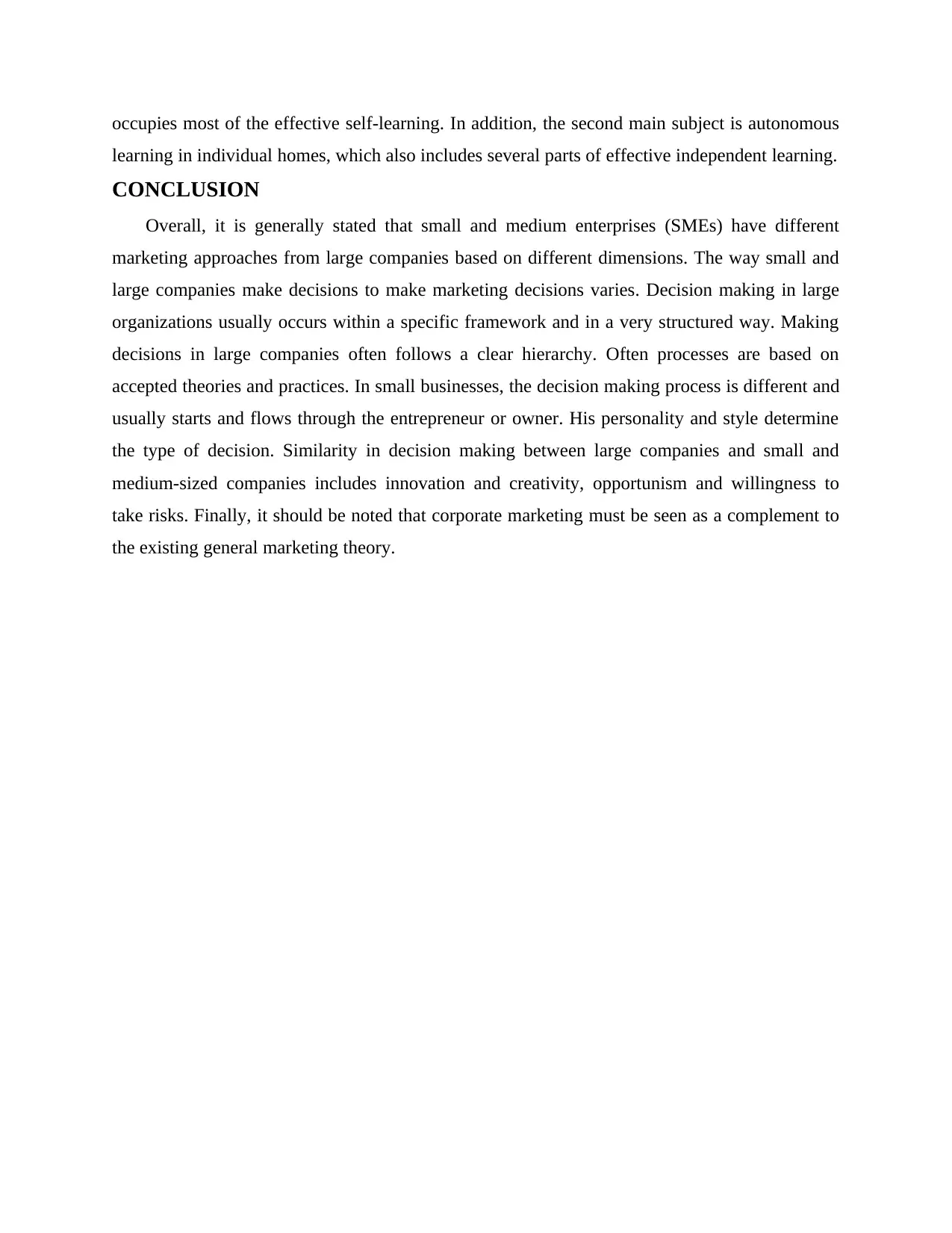
occupies most of the effective self-learning. In addition, the second main subject is autonomous
learning in individual homes, which also includes several parts of effective independent learning.
CONCLUSION
Overall, it is generally stated that small and medium enterprises (SMEs) have different
marketing approaches from large companies based on different dimensions. The way small and
large companies make decisions to make marketing decisions varies. Decision making in large
organizations usually occurs within a specific framework and in a very structured way. Making
decisions in large companies often follows a clear hierarchy. Often processes are based on
accepted theories and practices. In small businesses, the decision making process is different and
usually starts and flows through the entrepreneur or owner. His personality and style determine
the type of decision. Similarity in decision making between large companies and small and
medium-sized companies includes innovation and creativity, opportunism and willingness to
take risks. Finally, it should be noted that corporate marketing must be seen as a complement to
the existing general marketing theory.
learning in individual homes, which also includes several parts of effective independent learning.
CONCLUSION
Overall, it is generally stated that small and medium enterprises (SMEs) have different
marketing approaches from large companies based on different dimensions. The way small and
large companies make decisions to make marketing decisions varies. Decision making in large
organizations usually occurs within a specific framework and in a very structured way. Making
decisions in large companies often follows a clear hierarchy. Often processes are based on
accepted theories and practices. In small businesses, the decision making process is different and
usually starts and flows through the entrepreneur or owner. His personality and style determine
the type of decision. Similarity in decision making between large companies and small and
medium-sized companies includes innovation and creativity, opportunism and willingness to
take risks. Finally, it should be noted that corporate marketing must be seen as a complement to
the existing general marketing theory.
Paraphrase This Document
Need a fresh take? Get an instant paraphrase of this document with our AI Paraphraser
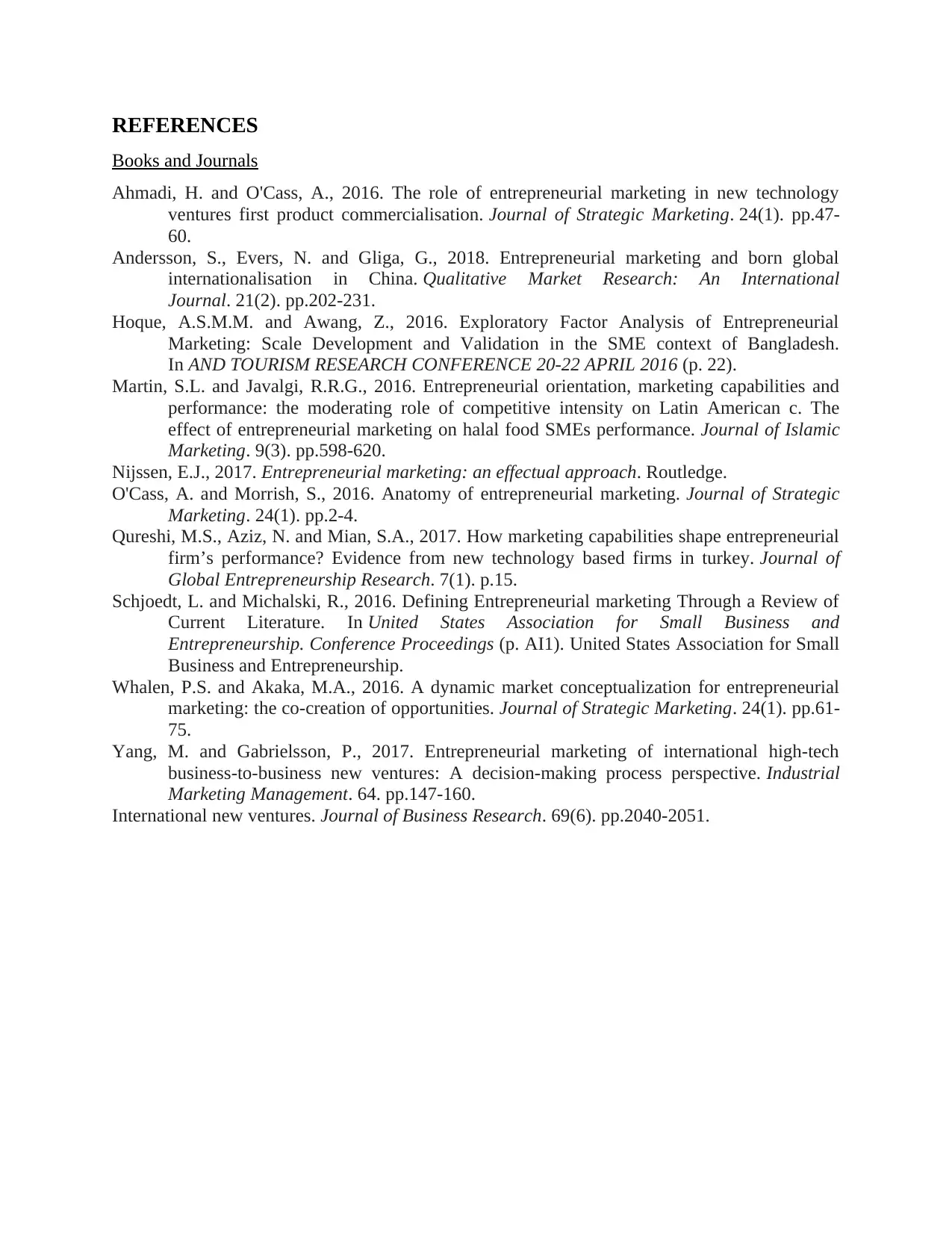
REFERENCES
Books and Journals
Ahmadi, H. and O'Cass, A., 2016. The role of entrepreneurial marketing in new technology
ventures first product commercialisation. Journal of Strategic Marketing. 24(1). pp.47-
60.
Andersson, S., Evers, N. and Gliga, G., 2018. Entrepreneurial marketing and born global
internationalisation in China. Qualitative Market Research: An International
Journal. 21(2). pp.202-231.
Hoque, A.S.M.M. and Awang, Z., 2016. Exploratory Factor Analysis of Entrepreneurial
Marketing: Scale Development and Validation in the SME context of Bangladesh.
In AND TOURISM RESEARCH CONFERENCE 20-22 APRIL 2016 (p. 22).
Martin, S.L. and Javalgi, R.R.G., 2016. Entrepreneurial orientation, marketing capabilities and
performance: the moderating role of competitive intensity on Latin American c. The
effect of entrepreneurial marketing on halal food SMEs performance. Journal of Islamic
Marketing. 9(3). pp.598-620.
Nijssen, E.J., 2017. Entrepreneurial marketing: an effectual approach. Routledge.
O'Cass, A. and Morrish, S., 2016. Anatomy of entrepreneurial marketing. Journal of Strategic
Marketing. 24(1). pp.2-4.
Qureshi, M.S., Aziz, N. and Mian, S.A., 2017. How marketing capabilities shape entrepreneurial
firm’s performance? Evidence from new technology based firms in turkey. Journal of
Global Entrepreneurship Research. 7(1). p.15.
Schjoedt, L. and Michalski, R., 2016. Defining Entrepreneurial marketing Through a Review of
Current Literature. In United States Association for Small Business and
Entrepreneurship. Conference Proceedings (p. AI1). United States Association for Small
Business and Entrepreneurship.
Whalen, P.S. and Akaka, M.A., 2016. A dynamic market conceptualization for entrepreneurial
marketing: the co-creation of opportunities. Journal of Strategic Marketing. 24(1). pp.61-
75.
Yang, M. and Gabrielsson, P., 2017. Entrepreneurial marketing of international high-tech
business-to-business new ventures: A decision-making process perspective. Industrial
Marketing Management. 64. pp.147-160.
International new ventures. Journal of Business Research. 69(6). pp.2040-2051.
Books and Journals
Ahmadi, H. and O'Cass, A., 2016. The role of entrepreneurial marketing in new technology
ventures first product commercialisation. Journal of Strategic Marketing. 24(1). pp.47-
60.
Andersson, S., Evers, N. and Gliga, G., 2018. Entrepreneurial marketing and born global
internationalisation in China. Qualitative Market Research: An International
Journal. 21(2). pp.202-231.
Hoque, A.S.M.M. and Awang, Z., 2016. Exploratory Factor Analysis of Entrepreneurial
Marketing: Scale Development and Validation in the SME context of Bangladesh.
In AND TOURISM RESEARCH CONFERENCE 20-22 APRIL 2016 (p. 22).
Martin, S.L. and Javalgi, R.R.G., 2016. Entrepreneurial orientation, marketing capabilities and
performance: the moderating role of competitive intensity on Latin American c. The
effect of entrepreneurial marketing on halal food SMEs performance. Journal of Islamic
Marketing. 9(3). pp.598-620.
Nijssen, E.J., 2017. Entrepreneurial marketing: an effectual approach. Routledge.
O'Cass, A. and Morrish, S., 2016. Anatomy of entrepreneurial marketing. Journal of Strategic
Marketing. 24(1). pp.2-4.
Qureshi, M.S., Aziz, N. and Mian, S.A., 2017. How marketing capabilities shape entrepreneurial
firm’s performance? Evidence from new technology based firms in turkey. Journal of
Global Entrepreneurship Research. 7(1). p.15.
Schjoedt, L. and Michalski, R., 2016. Defining Entrepreneurial marketing Through a Review of
Current Literature. In United States Association for Small Business and
Entrepreneurship. Conference Proceedings (p. AI1). United States Association for Small
Business and Entrepreneurship.
Whalen, P.S. and Akaka, M.A., 2016. A dynamic market conceptualization for entrepreneurial
marketing: the co-creation of opportunities. Journal of Strategic Marketing. 24(1). pp.61-
75.
Yang, M. and Gabrielsson, P., 2017. Entrepreneurial marketing of international high-tech
business-to-business new ventures: A decision-making process perspective. Industrial
Marketing Management. 64. pp.147-160.
International new ventures. Journal of Business Research. 69(6). pp.2040-2051.
1 out of 8
Related Documents
Your All-in-One AI-Powered Toolkit for Academic Success.
+13062052269
info@desklib.com
Available 24*7 on WhatsApp / Email
![[object Object]](/_next/static/media/star-bottom.7253800d.svg)
Unlock your academic potential
Copyright © 2020–2025 A2Z Services. All Rights Reserved. Developed and managed by ZUCOL.





